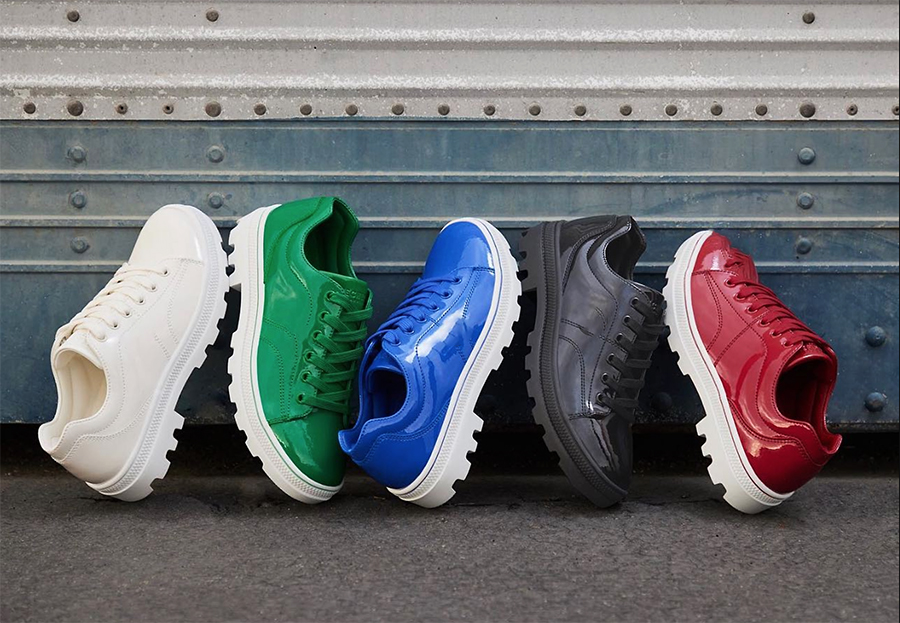Skechers USA, Inc. saw both sales and earnings easily surpass Wall Street targets as the company navigated supply chain congestion to meet robust demand for its comfort footwear. On an analyst call, David Weinberg, COO, said the supply chain situation finally appears to be improving.
“We saw improvements in December with more goods moving through our distribution centers than in the previous months,” said Weinberg. “The improvement continued through January as port congestions eased and more containers reached our distribution center. However, we believe these challenges will remain through the first half of 2022. But we are optimistic they will ebb in the latter half of the year.”
In the quarter ended December 31, earnings reached $402.4 million, or $2.56 a share, against $53.3 million, or 34 cents, a year ago. The latest results were boosted by an intra-entity transfer of certain intellectual property rights, partially offset by $15 million related to the settlement of multiple legal matters.
Excluding the effects of the tax benefits in both periods and the legal settlements, EPS on an adjusted basis rose 79.2 percent to 43 cents a share from 24 cents. Results were well ahead of Wall Street’s consensus estimate of 31 cents.
Sales in the quarter jumped 24.4 percent to a record $1.65 billion, topping Wall Street’s average target of $1.55 billion. The period marked the second-highest quarterly sales in the company’s history. On a constant-currency basis, its total sales increased 24.5 percent.
The gains resulted from a 9.8 percent increase in domestic sales and a 34.0 percent increase in international sales. Domestic and International growth was driven by increases in both wholesale and direct-to-consumer, with the largest improvement attributable to International Wholesale. International represented 65 percent of sales for the quarter.
Domestic Wholesale Expands 4.6 Percent
Domestic Wholesale sales grew 4.6 percent to $313.0 million. Domestic gross margin eroded 520 basis points to 32.5 percent. Improvements in Domestic Wholesale resulted from higher unit sales volume and higher average selling prices.
Weinberg said Domestic Wholesale growth came primarily from women’s and kids’ categories, though men’s running and walking categories also performed well.
“We believe our domestic wholesale growth is particularly positive, given the supply chain challenges that continue to impact consumers in the United States,” said Weinberg. “We were able to improve our deliveries in December from earlier in the quarter and are continuing to maintain a current flow of goods through our North American distribution center with the pace of shipments to our wholesale partners picking up, allowing us to better meet the demand for Skechers in our largest market.”

International Wholesale Revenues Jump 30 Percent
International Wholesale sales climbed 30.1 percent to $851.2 million. Gross margins eroded 290 basis points to 44.0 percent. The International Wholesale sale increases were driven by growth of 123.5 percent in Distributor sales, 61.3 percent in Europe, and 8.6 percent in China.
The Distributor business was led by the Middle East, followed by Russia, Scandinavia, Indonesia, and Turkey. Subsidiary sales increased 47 percent, with double-digit growth in nearly every country and several achieved triple-digit growth. The strongest gains came from the UK and India, two of Skechers’ largest markets. Said Weinberg, “We believe this impressive sales growth is due to both strong demand for our product and our ability to deliver goods as some of the port pressure eased.”
Skechers joint venture business increased 10 percent for the quarter on strong sales in China and Mexico and the addition of the Philippines, which transitioned from a distributor model to being directly managed by Skechers.
China’s high-single-digit growth in the quarter is notable, given temporary store closures in select provinces due to COVID-19 and supply chain restrictions, resulting in a delay of some 11.11 inventory.
DTC Revenues Advance 30 Percent
Direct-to-consumer (DTC) sales grew 30.3 percent to $483.7 million, driven by a 52 percent increase in international and a 17 percent increase domestically. Worldwide comparable same-store sales increased 21.1 percent, including 15.2 percent domestically and 35.5 percent internationally.
The 17 percent domestic DTC increase resulted from a 24 percent gain in brick-and-mortar stores, partially offset by a decrease of 12 percent in domestic e-commerce, which was challenged by low inventory during periods in the quarter. Compared to the same period in 2019, domestic e-commerce business surged 115 percent.
The increase in international DTC was primarily driven by strong retail sales across Europe and Latin America despite temporary pandemic-related store closures in Austria and the Netherlands.
E-commerce globally still achieved double-digit growth for the quarter. The rollout of new e-commerce sites continued in the quarter with new platforms launching in the UK, India, Germany, and Austria.
Gross Margins Impacted By Higher Freight Costs
Gross margins in the quarter were 48.6 percent, a decrease of 30 basis points. The erosion reflected higher freight expenses and the mixed impact of higher sales in its distributor business. These were partially offset by higher average selling prices.
As a percent of sales, operating expenses were reduced 160 basis points to 43.4 percent due to sales leverage. Operating expenses overall grew 20.1 percent to $715.1 million. The higher costs reflect increased costs for marketing, labor, volume-driven warehouse and distribution and the settlement of multiple legal matters.
Earnings from operations increased 61.2 percent to $93.1 million.
In the year, sales increased 36.7 percent to $6.3 billion, reflecting a 33.4 percent increase in domestic sales and a 39.0 percent increase in international sales, with the largest contribution from the International Wholesale growth. On a constant-currency basis, the company’s total sales increased 33.7 percent. Net earnings grew to $741.5 million, or $4.73 a share, from $98.6 million, or 64 cents, a year ago. On an adjusted basis, EPS improved to $2.59 from 65 cents a year ago.
Inventory Elevated Due to Transit Congestion
Total inventory was $1.47 billion at the quarter’s, an increase of $454.2 million or 44.7 percent from December 31, 2020. Increased inventory levels primarily reflect higher merchandise in transit due to supply chain challenges with shipping and port delays.
On the call, John Vandemore, CFO, said that the elevated inventory supported orders to wholesale accounts and DTC, which could not be sold in the quarter. He echoed Weinberg’s comments that Skechers has recently started to see an improvement in the delivery rate of containers and is optimistic this will continue. Said Vandemore, “We are monitoring events daily but expect some level of these challenges to persist well into 2022.”
Sales Expected To Climb Low Double-Digits In 2022
For the first quarter of 2022, sales are expected between $1.675 billion and $1.725 billion and EPS between 70 to 75 cents. In the 2021 first quarter, sales were $1.43 billion with EPS at 63 cents.
For fiscal year 2022, sales are expected between $7.0 billion and $7.2 billion and EPS between $2.70 and $2.90. The guidance translates to a sales gain of about 13 percent for 2022.
Weinberg said the strong results for 2021 place Skechers on track to meet its goal of $10 billion in revenue by 2026. He added, “While 2021 was a record year, we expect the momentum to continue into 2022.”
He said Skechers’ goal of delivering “comfortable footwear at a reasonable price” resonates with consumers worldwide. Expanded offerings with comfort fits, new collaborations and styles that incorporate recycled materials has broadened the brand’s appeal.
Investments continue in distribution and corporate infrastructure. In India, Skechers purchased its corporate headquarters in January and finalized the location for a new distribution center scheduled to open in 2023. It recently relocated its distribution center in Japan, more than doubling the square footage. In Panama, a relocation will expand Skechers’ distribution center space from 270,000 square feet to approximately 800,000 square feet in 2023.
Skechers said it would introduce more e-commerce sites in Spain, Portugal, and Italy. Numerous multi-platform marketing campaigns featuring its ambassadors are planned to drive brand awareness.
Said Weinberg, “We are finalizing plans to enter the metaverse, creating an entirely new opportunity for the Skechers brand and are further driving home the message that Skechers is the comfort technology company. “
Photos courtesy Skechers
















